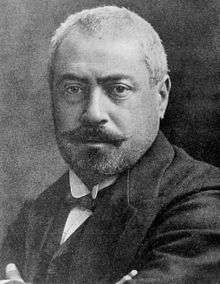Erik Josephson
Erik Semmy Josephson (7 March 1864 - 17 November 1929) was a Swedish architect. [1][2]

Biography
Josephson was born in Stockholm, Sweden. He was the son of wholesaler August Abraham Josephson (1822-67) and Augusta Hortensia Jacobsson (1836-1915). Josephson was of Jewish descent.[3] [4]
He graduated from the Royal Institute of Technology in Stockholm in 1885 and from the Royal Swedish Academy of Fine Arts in 1888. After his studies, he worked at the Swedish National Property Agency (Overintendentsämbetet). Through his state owned work employer he got the opportunity to draw, create and be the architect of about 40 barracks facilities for the armed forces around Sweden between 1891 and 1922.[5]
He also worked with his own architect firm on the side. During late 1890s and early 1900s, he became known as an industry architect and specialist in bank buildings. He designed only banks in Stockholm. Amongst his most important work was Skandinaviska Bankens palats and Handelsbanken.[6] He was one of the less publicly known architects in Stockholm. He was a style historic architect, also called an eclectic architect. He was categorized as a builder architect with an eye for the present time.[7]
References
- "Josephson, Erik (1864-1929)". KulturNav. Retrieved April 1, 2019.
- Tradition och identifikation : reflexioner kring svensk militärarkitektur Mats Ahnlund, libris=8588042
- Carine Lundberg. "Erik S Josephson". Svenskt biografiskt lexikon. Retrieved April 1, 2019.
- "Josephson, släkt". Svenskt biografiskt lexikon. Retrieved April 1, 2019.
- Magnus Isaeus' och Erik Josephsons byggnadsverk i Stockholm 1879-1927, Anne-Mari Neovius, libris=10599253
- Sveriges privata Centralbanks och Skandinaviska Kreditaktiebolagets nybyggnader, Erik Lallerstedt, 1918, libris=8863748
- Erik Josephson : en epok i svensk kasernarkitektur, 1971, Ejnar Berg, libris=1220579
Other sources
Berg, Ejnar (1971) Erik Josephson : en epok i svensk kasernarkitektur (Stockholm: Ejnar Berg) Berg, Ejnar (1975) Erik Josephson och svensk kasernarkitektur (Stockholm: Militärhistoriska förlaget)
External links
![]()